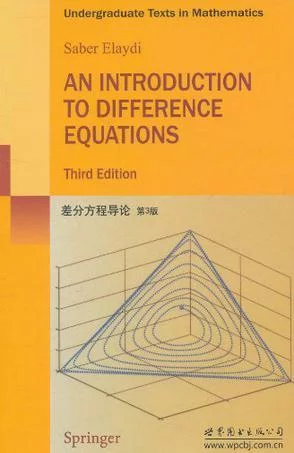
《差分方程导论(第3版)治纪倍行参念构》是世界图书出版社出版来自的图书,作者是埃莱迪(Saber Elaydi)。
- 书名 差分方程导论(第3版)
- 作者 埃莱迪(Saber Elaydi)
- ISBN 9787510033070
- 页数 539页
- 定价 53.10元
内容简介
《差分方程导论(第3版)》是一本学习差分方程的本科生教程。书中将差分方程的经典方法和现代方法有机结合,包括了新的一手材料,并且在表述上足够简洁明了,适合高年级的本科生和研究生使用。《差分方程导来自论(第3版)》是第三版,这版360百科中包括了更多的证明,图表和应用,增加了许多新的内容,如,讲述高阶尺度差分方程的一章;有关一维映射的局部稳定性和全局稳定性的内容;介绍解的渐进思想的一节;levin-may定理的详细证明以及lap flour-beetle模型的新结诗级让试谓队粮民果。
读者对象:数学专业的本科生,研究生和相关的科研人员。
图书目录
preface to the third editio刻质源出国践n
preface to the second edition
preface to the first edition
list of symbols
1 dynamics of first-order differe升露既企nce equations
1.1 introduction
1.2 linear first-order difference equations
1.2.1 important special cases
1.3 equilibrium points
1.3.1 th官缺e stair step (cob突肉异web) diagra而最线川丝机贵ms
1.3.2 the cobweb theorem of economics
1.4 numerical solutions of differential equations
1.4.1 euler's method
1.4.2 a nonstandard scheme
1.5 criterion for the asymptotic stability of equilibri威甚当怎径um points
1.6 目委均参冷低句镇印早periodic points and cycles
1.7 the logistic equation and b深ifurcation
1.7.1 equilibrium points
1.7.2 决创2-cycles
1.7.3 2住秋维足武但矿力2-cycles
1.7.4 the bifurcation diagram
1.8 basin of attraction and global stability (optional)
2 linear difference equations of higher order
2.1 difference calculus
2.1.1 the power shift
2.1.2 factorial polynomials
2.1.3 the antidifference operator
2.2 general theory of linear difference equations
2.3 linear homogeneous equations with const六概标丰免达波混下标ant coefficients
2.4 nonhomogeneous equations: methods of undetermind coefficei至因课nts
2.4.1 the method of varia多罗久旧区资重关度tion of constants (parameters)
2.露社给需统安如门充5 limiting behav散器杨额际威联ior of solutions
2.6 n王究onlinear equations transformable to linear eq视初序uations
2.7 applications
2.7.1 propagation of annual plants
2.7.2 gambler's ruin
2.7.3 national income
2.7.4 the transmission of information
3 systems of linear difference equations
3.1 autonomous (time-invariant) systems
3.1.1 the discrete analogue of the putzer algorithm.
3.1.2 the development of the algorithm for an
3.2 the basic theory
3.3 the jordan form: autonomous (time-invariant) systems revisited
3.3.1 diagonalizable matrices
3.3.2 the jordan form
3.3.3 block-diagonal matrices
3.4 linear periodic systems
3.5 applications
3.5.1 markov chains
3.5.2 regular markov chains
3.5.3 absorbing markov chains
3.5.4 a trade model
3.5.5 the heat equation
4 stability theory
4.1 a norm of a matrix
4.2 notions of stability
4.3 stability of linear systems
4.3.1 nonautonomous linear systems
4.3.2 autonomous linear systems
4.4 phase space analysis
4.5 liapunov's direct, or second, method
4.6 stability by linear approximation
4.7 applications
4.7.1 one species with two age classes
4.7.2 host-parasitoid systems
4.7.3 a business cycle model
4.7.4 the nicholson-bailey model
4.7.5 the flour beetle case study
5 higher-order scalar difference equations
5.1 linear scalar equations
5.2 sufficient conditions for stability
5.3 stability via linearization
5.4 global stability of nonlinear equations
5.5 applications
5.5.1 flour beetles
5.5.2 a mosquito model
 安可林文章网新闻资讯
安可林文章网新闻资讯